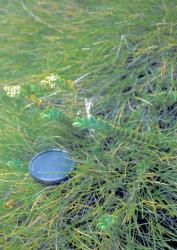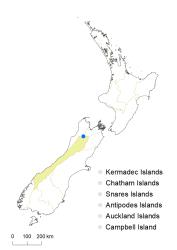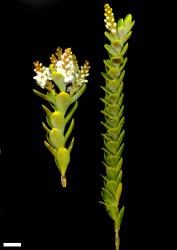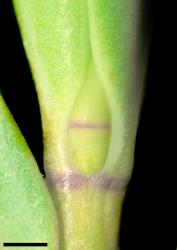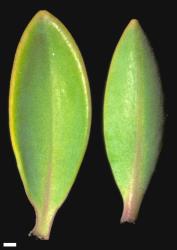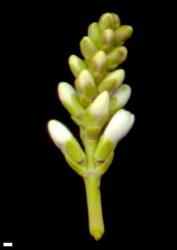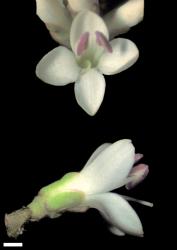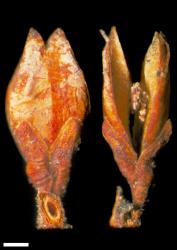- ≡ Hebe societatis Bayly & Kellow in Bayly et al., New Zealand J. Bot. 40: 576 (2002)
Spreading, low shrub to 0.3 m tall. Stems decumbent to ascending, eglandular-pubescent; hairs bifarious. Leaf bud distinct, its leaves appressed at margins until fully grown; sinus acute. Leaves sub-distichous to opposite-decussate, erect to erecto-patent; lamina coriaceous, elliptic to ovate, 5–37 mm long, 2–10 mm wide, dull, glaucescent to glaucous above and beneath; midrib evident; surfaces mostly glabrous but with eglandular hairs along midrib and near base above; margin glabrous or sparsely ciliolate, entire; apex sub-acute to obtuse and weakly plicate-acuminate; base abruptly cuneate; petiole 1–2 mm long. Inflorescence a lateral spike or raceme, 15–35 mm long; flowers crowded, 10–25, all bisexual; bracts opposite below, alternate above, sub-circular to elliptic to broadly deltoid, > pedicels; pedicels erecto-patent, 0.2–2.0 mm long, eglandular-hairy all around. Calyx lobes 4, free or the anterior fused up to ⅔-way, obtuse to rounded, 1.5–2.5 mm long, sub-equal, mixed glandular- and eglandular-ciliolate. Corolla 7–9 mm diameter; tube white, 2.0–2.5 mm long, ≥ calyx, glabrous; lobes 4, white, sub-erect to spreading, sub-equal, elliptic to ovate or orbicular, 3–4 mm long, sub-acute to rounded; nectar guides absent. Stamen filaments white, 2.8–3.5 mm long; anthers purple to magenta. Style glabrous, 5.0–5.5 mm long. Capsules latiseptate, sub-acute to acute, glabrous, 3.7–5.0 mm long, 2.4–3.2 mm at widest point. Seeds not described.
The decumbent to ascending stems are sparingly branched, and this, combined with the glaucescent to glaucous leaves, acute leaf bud sinus, very short pedicels, and short bracts, gives V. societatis plants a distinctive appearance.
V. dilatata plants can be quite similar, but their inflorescences are either tripartite or, if simple, have a pair of empty bracts at the base. V. dilatata plants also have a broader leaf bud sinus and a different chromosome number.
The growth form of V. vernicosa can be similar and it shares an unusual chromosome number with V. societatis, but V. vernicosa plants have glossy green leaves, shorter calyx lobes and corolla tubes, and pale anthers. V. canterburiensis plants are also similar, and also occur on Mt Murchison, but they have hairy petioles beneath and glossy green leaves.
South Island: Westland (known only from Mt Murchison, Braeburn Range, where the plants are found on a small area of grassland on the north-east side of the peak).
Steep, north-east-facing, low sub-alpine slope in Chionochloa australis turf. Recorded elevations range from 1340 to 1450 m.
Flowers: January–February; fruits: February–March.
2n = 42 (see Bayly & Kellow 2006, as Hebe societatis).
Veronica societatis is classified in V. subg. Pseudoveronica sect. Hebe and the informal group “Apertae” (small-leaved) (Albach & Meudt 2010; Bayly & Kellow 2006). Its similar morphology and chromosome number to V. vernicosa suggest a relationship, but this has not been explicitly tested.



